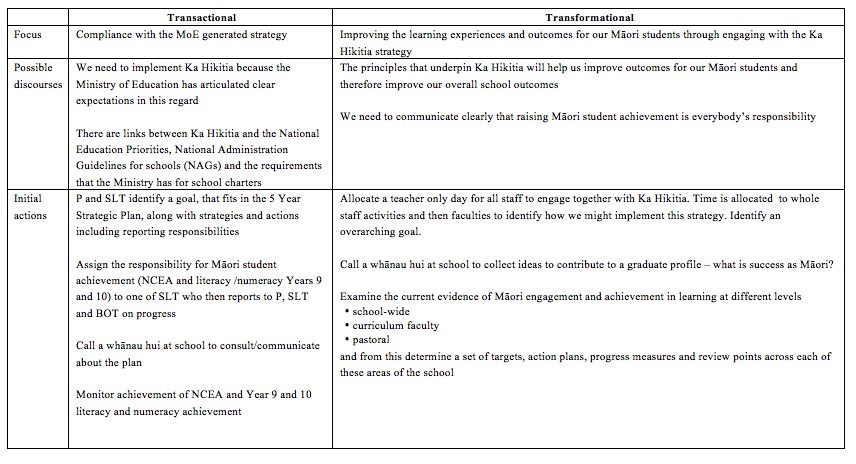9
The leadership influence
The role that school leaders take on, in disrupting and changing the status quo of Māori underachievement, is crucial. In order to do this, leaders need to understand that:
- schools have traditionally had a role in reproducing the fabric of this society,
- leaders are part of the power base, and
- under the Treaty of Waitangi and within their own sphere of influence, school leaders have the power and the mandate through Ka Hikitia to make more of a difference for marginalised students, especially Māori students.
How leadership is undertaken and evolves in schools can accelerate or hinder the social change required to address these disparities.
Leadership perspectives for consideration
In considering different theories of leadership, the notion that an individual leader might work largely from one model or style has led to descriptions of leadership practice according to type.
It is more useful to think of leadership from different perspectives as the reality of practice in different contexts is more complex and cannot be reduced or limited to one type.
In this section, we identify four different perspectives on leadership and consider their relevance in addressing and eliminating the current achievement disparities in schools.
It is important to go back to the “Leadership” literature to get a better understanding of the following perspectives and how they might be relevant for school leaders in disrupting and changing the status quo of Māori underachievement.
- Bass, B. M. (1990). From transactional to transformational leadership: Learning to share the vision. Organizational Dynamics, (Winter): 19-31.
- Harris, A. (2005). Leading or Misleading: Distributed Leadership and School Improvement. Journal of Curriculum Studies, 37(3), 255-267.
- Spillane, J. (2006). Distributed leadership. San Francisco, CA: Jossey-Bass.
10
- Shields, C. M., (2013). Transformative leadership in education: Equitable change in an uncertain and complex world. New York, NY: Routledge.
- Shields, C. (2010). Transformative leadership: working for equity in diverse contexts. Educational Administration Quarterly, 46(4), 558-589.
Distributed leadership
The notion that leadership is a collective and dynamic undertaking, grounded in shared activity rather than positions or roles, is central to distributed leadership.
This perspective on leadership is concerned both with process (how leadership occurs and is shared within and across organisations both vertically and laterally) and with capacity building (how leadership is enhanced and developed).
A distributed perspective urges us to view leadership as a lateral form of agency (Harris, 2005).
Distributed leadership emerges from the actions and interactions of individuals engaged with each other in problem solving and/or developmental work. It promotes a relational influence - the ability to influence the practices of others in ways that bring about major changes (Spillane, 2006).
Collectively and collaboratively constructing meaning and knowledge within and across groups, in particular contexts, provides opportunities to reveal and mediate perceptions, values, beliefs, information and assumptions.
There is increasing evidence to suggest that more widely distributed patterns of leadership equate with greater potential for organisational change and development.
Whānau groups working together on the marae provide an example of distributed leadership.
Each individual has their own part to play in terms of responsibility, decision making and collaborative action to support the evolving kaupapa (common agenda).
Each individual is recognised and trusted for the contribution that they will make to the collective.
All roles are interrelated so that the organic and dynamic undertaking is successful, the whānau is supported and the mana of the kaupapa in terms of the contribution made by the marae is upheld.
Given the cultural connections that can easily be applied in the case of distributed leadership, this is a model that is often held up as one that might most usefully be applied, when working in Māori cultural contexts.
11
While we would agree with this position, we also want to consider three other leadership perspectives when seeking to bring about schoolwide reform in order to serve students more equitably.
These leadership perspectives are transactional, transformational and transformative.
Transactional leadership
Foundation ideas that support transactional leadership include the views that people are motivated by reward and punishment and that social systems work best with a clear chain of command.
A leader working from the transactional standpoint creates structures and institutions that clarify what is required of their subordinates, using goals, expectations and standardised practices.
Such leaders are extrinsic motivators who work to gain compliance from their followers, often giving constructive feedback to keep them on task.
Using management by exception is common – if something is working then it does not need attention (if it ain’t broke don’t fix it). For subordinates, exceeding expectations earns praise and reward, while performance below the expectation requires corrective action of some sort.
Achieving increased efficiency of operations and raising productivity or performance is the main focus of transactional leadership – following the rules rather than making changes to the structure or culture of the organisation.
Transactional leadership practice works within the existing systems and culture to attain goals and maintain the status quo. Coaches of sports teams provide an example of transactional leadership. These coaches motivate their squad members by promoting the reward of winning the game. They instil such a high level of commitment that their teams are willing to risk pain and injury to obtain the results that the coach is asking for.
Transformational leadership
The ability to engage with followers by being genuine, inspirational and influential is essential to transformational leadership. This leadership perspective is centred on the promotion of a consistent vision, mission, and set of values. The qualities and role modelling of the leader are fundamental.
12
This leadership practice is concerned with establishing and maintaining relationships of trust, articulating an unswerving and inspiring vision and purpose, encouraging innovation and creativity and nurturing a culture of teamwork and commitment in order to carry out that vision.
Because such a leader engenders high levels of optimism and energy, and offers followers an inspiring mission and vision, as well as fostering a collective identity, these ‘devotees’ are prepared to work harder than originally expected.
Followers are encouraged to work beyond their comfort zones, come up with new ways to challenge the status quo and to change the organisation to support individuals and the organisation as a whole being increasingly successful.
Bill Gates’ leadership as co-founder and CEO of Microsoft Corporation could be described as transformational.
Articulating a clear vision, sustaining high energy levels across the organisation for enacting this vision, upholding excellence in performance standards, nurturing innovative approaches and supporting the morale of well-motivated employees characterises Bill Gates’s leadership practice.
Transformative leadership
Transformative leadership begins by understanding inappropriate uses of power and privilege and then seeking to challenge and change these situations through their own practices.
This perspective on leadership takes seriously the personal and the public responsibility to use power, privilege, and position in the context to promote social justice and enlightenment for the benefit, not only of individuals, but of society as a whole (Shields, 2010). Such leadership practice requires attending to the needs and aspirations of the wider community in which one serves.
As a result of a deeper understanding of the differing power relations within which we all live, transformative leadership then seeks to engage with change. Eight key principles of transformative leadership include:
- the mandate to effect deep and equitable change
- the need to deconstruct and reconstruct knowledge frameworks that perpetuate inequity and injustice
- a focus on emancipation, democracy, equity, and justice
13
- the need to address the inequitable distribution of power
- an emphasis on both individual and collective good
- an emphasis on interdependence, interconnectedness, and global awareness
- the necessity of balancing critique with promise
- the call to exhibit moral courage.
Madiba (Nelson Mandela) exemplifies transformative leadership.
All eight tenets are easily recognisable in his life’s work, from his early days working as a lawyer, participation in and leadership of the ANC, the twenty-seven years imprisonment, and in his role as leader of the Government for National Unity (the first elected president in fully representative democratic elections in South Africa).
As president, Madiba set an example of reconciliation and a vision of emancipation, democracy, equity and justice for his countrymen – a free South Africa – and then let them know he expected them to live up to it.
“For all people who have found themselves in the position of being in jail and trying to transform society, forgiveness is natural because you have no time to be retaliative.”

14
Transformative, Transactional and Transformational
Shields (2010) suggests that while these three leadership perspectives are underpinned by some similar and some quite different principles, leaders will quite often move from one leadership type to another in an almost unconscious manner.
In order to be more determined about our practice and thus accelerate the impact of our actions we have deconstructed these leadership perspectives according to some contextual features for leaders to consider against some examples of their own leadership practices.
Leadership perspectives [Download 2]
Activity
In the following table (Table 1) consider the contexts of: focus, discourses, relationships, goal, actions, outcomes, benefits and challenges.
- How do these examples compare with your understandings of your own practice? Can you think of some examples when this happened?
- What do you think of Shields’ contention that leaders will often move from one leadership type to another? Why do you think this?
- What would you hope to take from this activity?

15
Table 1: Leadership perspectives and contextual features
16






